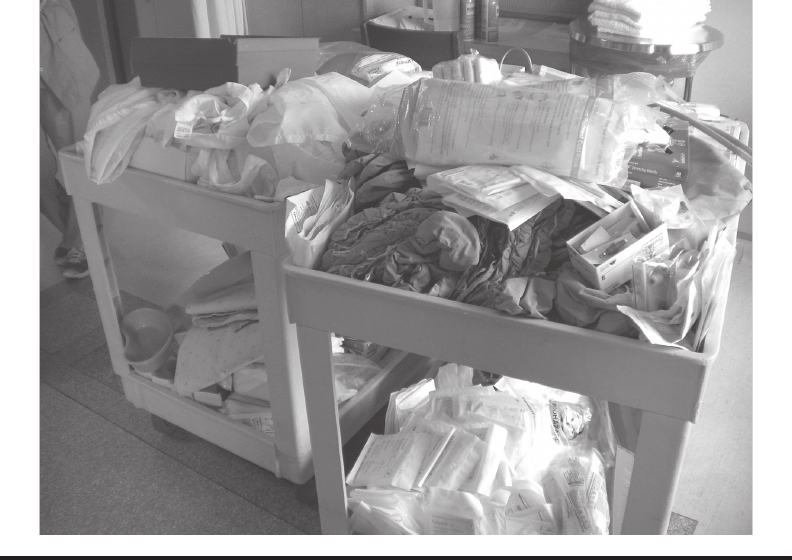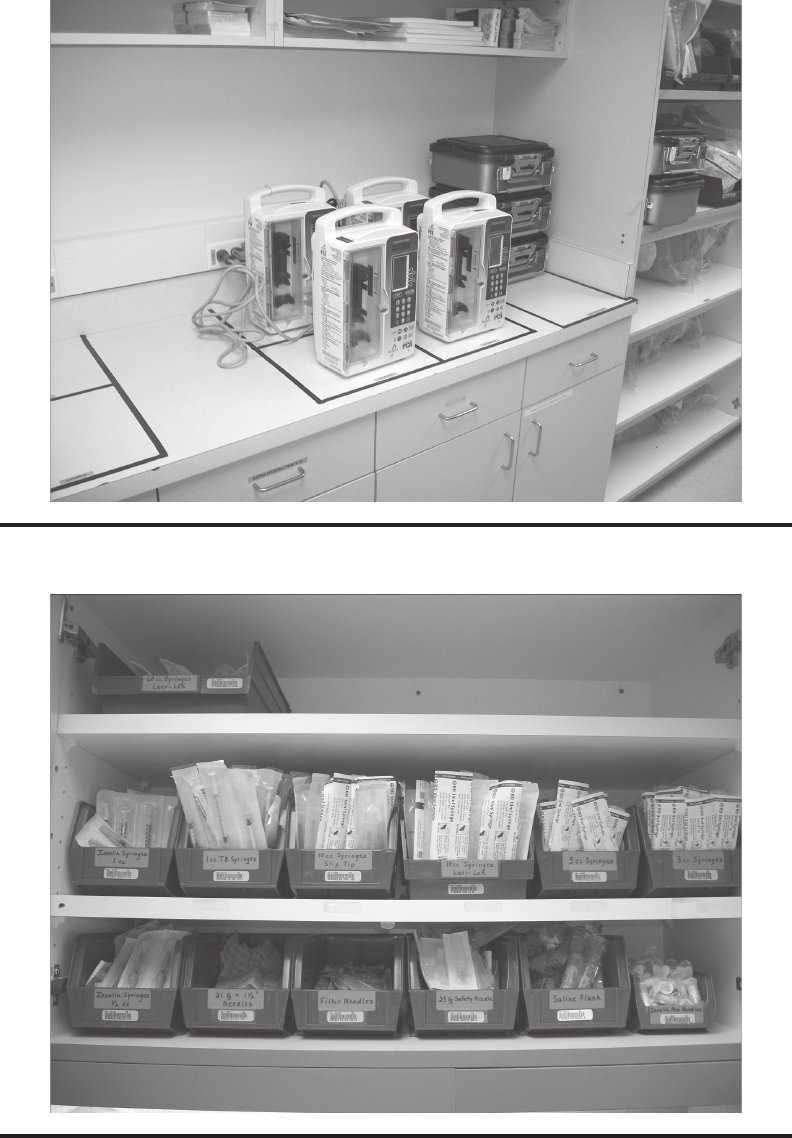
Lean in Healthcare ◾ 147
◾ Potential failure point: e area looks good now (decluttered). Colleagues feel like lots of
unneeded supplies and equipment were removed and there is plenty of extra space now.
As a result, managers and leaders decide there is no need to go forward with the next
four steps.
◾ Result: If a 5S event concludes now, freed up space will be squandered and unnecessary
items will creep back into the area.
2. Set in Order: A Place for Everything and Everything in Its Place
Once supplies are reduced to only those necessary, our next “S” is to Set in Order, that is, arrange,
organize, and create an address (home location) for everything that remains. Designate storage
locations based on function and frequency of use of the item stored: frequently needed items
should be placed close to the point of use; occasionally needed items should be placed in a central
location in the department; and seldom needed (but required) items should be placed in a central
location within the organization. All signage or labeling should be clearly visible and self-explan-
atory so everyone can identify at a glance where anything belongs (Figure17.5). Information on
the label should include item name, location address, quantity required, and a product barcode
(if applicable). Labeling conventions and nomenclature should be standardized within the entire
organization (Figure17.6). Using a color-coding scheme (Figure17.7) enhances the visual work-
place and allows for ease of nding needed items. e goal of Set in Order is: easy to nd, easy to
use, easy to return.
Figure 17.4 (Continued ) St. John’s Hospital Birth Center patient room and clean utility storage
sort.

148 ◾ Karl Kraebber
Figure 17.5 Home locations (St. John’s Hospital, Birth Center Clean Utility).
Figure 17.6 Standardized labels (St. John’s Hospital, Birth Center Medication Room).

Lean in Healthcare ◾ 149
3. Shine: Not Only Cleaning, but Seeing What Is Getting Dirty
is step in 5S is a deep cleaning of the area to establish a new baseline for departmental cleanli-
ness. All surfaces, including oors, walls, ceilings, as well as equipment and furniture, should be
maintained in like-new condition. Scheduled audits and routine cleaning of the area is done by
any assigned colleague (not only housekeeping) because an unclean environment cannot produce
quality care and be safe. Abnormalities are readily visible when a workplace is regularly cleaned
and organized.
◾ Potential failure point: e area really looks good now. It’s clean and well organized.
Colleagues are disciplined so there is no need to standardize. It will be self-sustaining.
◾ Result: If a 5S event concludes now, improvements will be short lived, items and supplies
will nd new home locations, and cleanliness will not be top of mind.
4. Standardize: The Difference between a 3S Project and a 5S Way of Life
Step 4 transitions healthcare organizations from the active phase to the maintenance phase of 5S.
Standardization starts with creating a 5S map (annotated oor plan or picture; see Figure17.8)
and schedule of responsibilities. e schedule of responsibilities clearly articulates what needs to
5S YES – NO Standard
BEFORE and AFTER photos may be used to
provide an unambiguous standard
YES! NO!
Photographs are from the same view
Figure 17.8 5S standardization image.
Color
Red
Yellow
Brown
Blue
Orange
Green
White
Meaning
IV supplies/needles
Urinary supplies
GI / Ostomy supplies
Respiratory supplies
ADL supplies
Dressing supplies
Miscellaneous
Symbol
1
2
Figure 17.7 Color-coding convention.

150 ◾ Karl Kraebber
be done on a daily, weekly, and monthly basis to maintain order and cleanliness. Standard work
documents should also be developed to capture 5S duties in a standardized format (used for new
employee training and current employee remediation). A 5S checklist should be developed that
identies and denes what will be done. When and who is responsible is another tool to assist with
standardization. It is the responsibility of everyone in a department to maintain the organized
workplace and prevent regression to a cluttered and unorganized environment.
Another important tool of a Lean organization that supports a visual workplace and facili-
tates ow is Kanban. Kanban is a Japanese word that means “signboard.” In a Lean organiza-
tion, Kanban is a pull signal initiated by consumption from an upstream process or depletion to
a dened replenishment point. Kanbans may be text pages, replenishment cards (Figure17.9),
or even empty bins. Either the card is placed at the reorder point or the par level is split in half
between two bins (Figure17.10). Kanban signals authorize production or delivery of required
materials, supplies, and so on. Kanban allows a JIT environment to be set up; however, it requires
level or balanced production and built-in quality (defect-free products). Kanban is a high-level
Lean tool that is implemented after initial problem solving and waste elimination eorts.
5. Sustain: You Get What You Inspect, Not What You Expect
Since human nature during change is to revert to past comfortable practices, departmentwide pro-
motion of discipline is paramount. Leadership and management must reinforce 5S responsibility,
standards, and schedules. Audits should be conducted on a regular basis by designated colleagues.
It is also important to document and share the 5S process with before-and-after 5S photo exhibits
(Figure17.11 and 17.12). Recognize those who participated in the event and share the outcome
with other areas in the organization via hospital newsletters, management meetings, and whole
hospital meetings.
When implementing 5S, colleagues can rapidly improve the workplace environment with
a minimal expenditure. Most organizations report 5%–10% eciency improvement in several
Kanban
Example
Description
Item Number
Supply Room
Kanbans Route Information in a Pull System
Par Level
Item Location
Barcode
Figure 17.9 Example Kanban card from St. John’s Hospital main operating room.

Lean in Healthcare ◾ 151
months, 25%–50% reduction in inventory, 50%–100% reduction in time searching for needed
items, and one-time supply cost credits. At St. John’s Hospital, the birth center realized a 42%
reduction in inventory (translating to $4,200 worth of supplies no longer on the shelves), a 50%
reduction in the time required to nd needed supplies, and a one-time supply credit of over $4,500.
With the implementation of a Kanban replenishment system in the main operating room at St.
John’s Hospital, supply stockouts have virtually been eliminated, 7–8 daily trips to central supply
have become (at most) 1–2 weekly trips, and all case carts are completed the day prior to the case
due to proper supply availability. While change is often received with a sense of apprehension,
participants in the 5S activities begin to taste change as something that can be positive and even
fun, paving the way for a true Lean transformation in healthcare.
Benets of Lean in Healthcare
Lean systems have the ability to provide far-reaching benets to all stakeholders in the healthcare
system. Lean provides healthcare organizations with a methodology to systematically improve the
IOM Six Dimensions of Quality (IOM, 2001), including:
1. Safe: Improved safety; reduced errors
2. Eectiveness: 70% to 90% lead time reduction
3. Ecient: 50% to 80% inventory reduction
Figure 17.10 Example Visual Controls from St. John’s Hospital main operating room.
Continued
..................Content has been hidden....................
You can't read the all page of ebook, please click here login for view all page.
